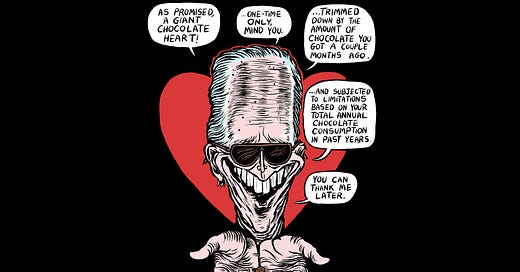Talking With Eli Valley About Art in the Hell Times
Today in 'What Now': we chat with the most merciless satirist of our era.
Hi-diddly-ho bloggorinos! Rafi here, with this week's WHAT NOW? and what a week it is. It's a sweltering 40 degrees in Minnesota today — shorts and t-shirt weather, really — and I'm already picturing myself sipping brightly colored drinks from a hollowed-out coconut, with at least four or five tiny umbrellas tossed on top for good measure. For now, though, I'll find my satisfaction how much you're sure to enjoy this week's interview with artist and cartoonist Eli Valley. You're gonna love it, I promise.
I’ve had the pleasure of being friends with Eli for years, having watched him go from a chronicler of Jewish communal dysfunction as artist-in-residence for The Forward to one of the most insightful, mercilessly accurate satirists of the Trump era and beyond. So when it was my turn to take the helm of this newsletter, I leaped at the excuse to give him a call. We were able to cover all sorts of great stuff, like Japanese manga, Brendan Fraser’s The Mummy (1999) and the sincere challenges of creating art in the Biden era. Check out Eli’s Patreon and Twitter account for more.
This interview has been edited and condensed for clarity.
Rafi: Have you just spent the past year sitting in your apartment drawing?
Eli: A bit. Like in the summer I would go for walks and on occasion, I would meet up with friends — socially distanced of course — in a park, but not frequently.
Rafi: Your productivity has gone way up over the past year, it seems.
Eli: I don’t think it has. People have said to me in the past, when I don’t feel productive, they say, "wow you’re so productive." I don’t know if I just don’t see it the way other people see it or what. I’m very self-critical of my output and the amount of time and energy I put into each work. But I will say that unlike people who are commuting to an office, the pandemic wasn’t as disruptive for me in that respect, because I’m just sitting at my computer drawing. And so I’ve been fortunate in that regard. But obviously, the social isolation has taken a toll on everyone.
Rafi: I don’t remember who it was who said it — It might have been Amanda Palmer? [note: it was!]— But someone was like "People are going to make great art in the Trump years." And it’s like a total indulgent, jerk-off statement. But I feel like you have made great art in the Trump years! How do you see the sort of inspiration that it provided as compared to the work that you’ve done before and the work that you’re doing now that the Trump years are over?
Eli: Prior to the Trump years, I was doing very Jewish communal, Israel-oriented comics and I actually was hoping to move beyond political work and do more, you know, fictional or memoir-ish type of graphic comic art. And then Trump just upended everything. I guess one could argue that he was such a cartoon villain that it’s actually not difficult to be outraged and to make outrage art. But on the other hand, like when you look at a lot of the outrage, especially — and not to be generationally cruel — but the boomer type of shit, I’m sure you’ve seen it. Well, I mean, the obvious stuff is like, you know, homophobic stuff with Putin. You know, that stuff is really, really crappy. But it actually disturbs me because boomers seem to love that stuff. It’s just very disappointing about what people like. So people are outraged. And you can make awful art out of outrage, it turns out. I don’t know what to say about my own art — hopefully it’s not like that. But basically, the criticism that I can see is that because Trump is a cartoon villain, drawing against this cartoon villain is just more self-evident, whereas drawing in a more sort of nuanced and insidious kind of political environment is more challenging, and that might be the case.
Keep reading with a 7-day free trial
Subscribe to Discourse Blog to keep reading this post and get 7 days of free access to the full post archives.





